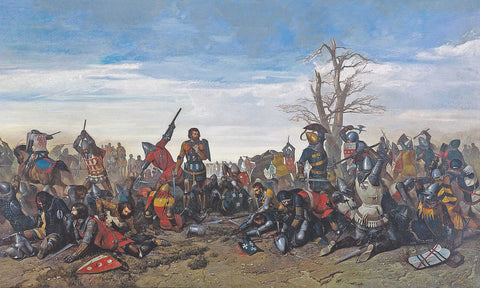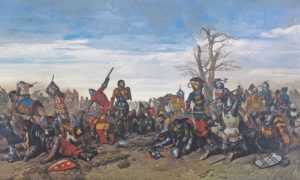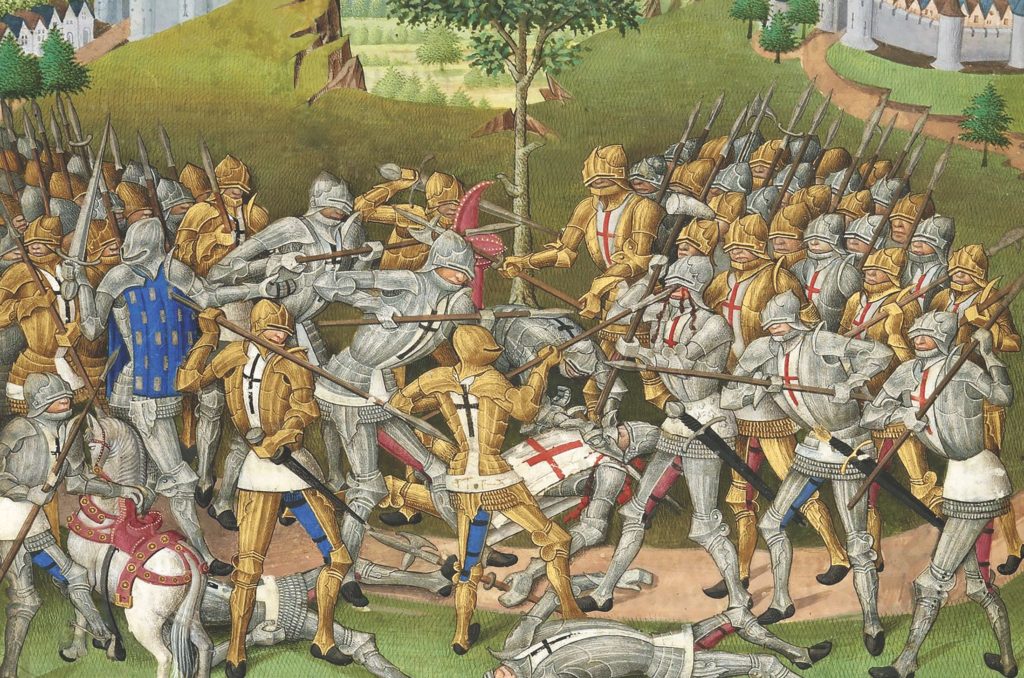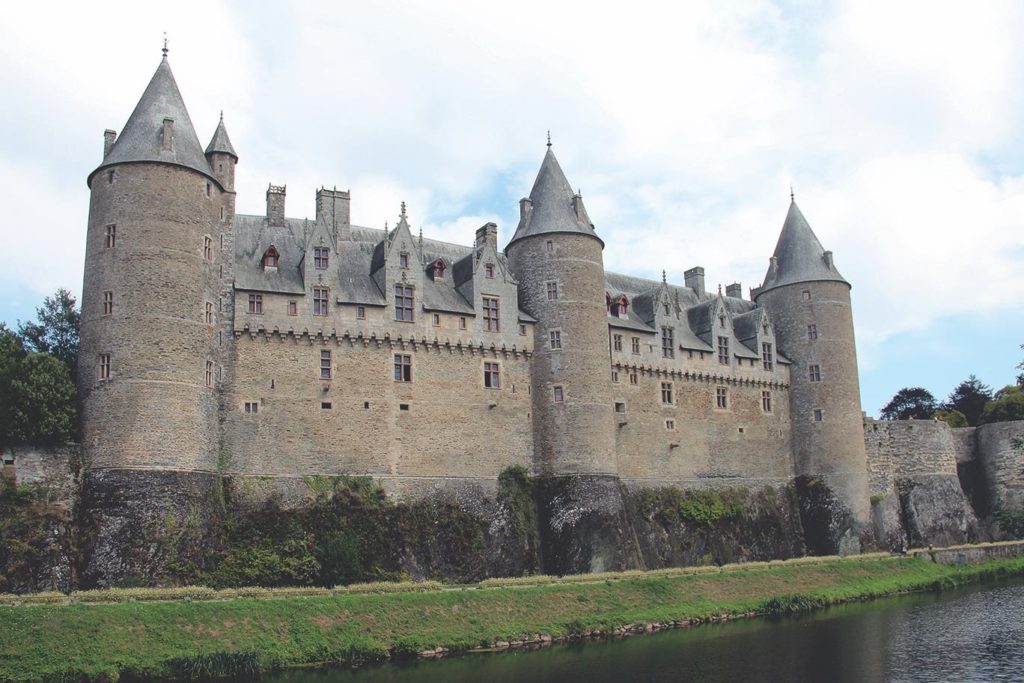
30 Knights Paused a War — to Fight a Battle Royale Death Match

On March 26, 1351, in the Duchy of Brittany in western France, two teams of knights, squires and men-at-arms faced off across a field midway between Josselin and Ploërmel castles. Though it was springtime and far from the dog days of summer, sweat streamed down the faces of those assembled. From either side men clad in 30 pounds of armor took the measure of their opposition in anticipation of the coming engagement.
Jean de Beaumanoir, the French governor of Josselin Castle and champion of the House of Blois claim to Brittany, strode out to midfield to formally challenge his rival, Sir Robert Bemborough, the English captain of Ploërmel castle and champion of the House of Montfort claim to the duchy. Each had mustered 30 men on this predetermined day to give battle in what would become known as the Combat of the Thirty. Its outcome would not settle the ongoing War of the Breton Succession but was a question of chivalric honor.
The War of the Breton Succession
The War of the Breton Succession erupted in 1341 after John III, Duke of Brittany, died that April 30 without an heir, but after having named rival successors to his ducal title. One was his niece, Jeanne de Penthièvre, wife of Charles of Blois, the latter a nephew of French King Philip VI. The other was his formerly estranged younger half brother, John de Montfort. With a mercenary army to back him, Montfort gained the support, or at least submission, of the principal Breton towns, as well as control of the ducal treasury. While an assembly of townspeople and minor nobles recognized him as duke that May, he enjoyed only marginal acceptance among the upper nobility.
Courting the military might of the French crown in their effort to wrest Brittany from Montfort, Charles and Jeanne appealed to Uncle Philip for assistance. At the same time Montfort negotiated with English King Edward III for support. France and England had recently signed a truce in the broader Hundred Years’ War (1337–1453), which centered on competing claims over the Duchy of Aquitaine and the French throne itself after the 1328 death of Charles IV without a male heir. The succession crisis in Brittany provided Edward an excuse to resume hostilities and open another front against Philip, further sapping French resources and possibly providing the English a foothold in western France.
this article first appeared in military history magazine
Word of Montfort’s negotiations with the English reached Philip, who formally recognized Charles and Jeanne’s ducal claim and furnished them with troops. In early October the king’s nephew led an army of 5,000 French soldiers, 2,000 Genoese mercenaries and a contingent of Bretons against John’s strongholds. Though Montfort had secured Edward’s promise of military aid, it arrived too late. After back-to-back defeats at Champtoceaux on October 26 and Nantes on November 2, John was captured and imprisoned in Paris.
The period following Montfort’s imprisonment has been dubbed the War of the Two Jeannes, as it pitted Bloisists loyal to Jeanne de Penthièvre against Montfortists led in John’s absence by Jeanne de Flandre, his French wife. In the wake of John’s capture the Montfortists lost support and fared poorly, by fall 1342 forfeiting all but the garrisoned port of Brest. The subsequent arrival of promised English forces would expand the internal War of the Breton Succession into a proxy war between England and France. It proved troublesome for both.
In early August 1342 William de Bohun, Earl of Northampton, sailed from Portsmouth with some 1,350 English soldiers in 260 coastal transports, followed days later by 800 men under disaffected Breton noble Robert of Artois. Panicked by the English fleet’s arrival off Brest, Charles broke his siege and fled.
Securing Breton reinforcements that expanded his force to some 2,500 men, Northhampton moved inland to besiege the Bloisist fortress of Morlaix. Though the size of either army remains in debate, Charles and a far larger French army moved to break the siege. The outcome of the September 30 clash proved inconclusive, the English pulling back into the woods, secure from enemy cavalry, and the French largely withdrawing after having suffered steep losses, including 50 knights killed.

A flurry of diplomatic and military activity followed. In January 1343 Pope Clement VI played mediator, securing the Truce of Malestroit in hopes France and England could work out their differences before the pact’s September 1346 expiration. It proved a vain hope, due largely to nonstop partisan fighting between Bloisist and Montfortist factions. Philip’s execution of prominent Montfortist captives in 1344 didn’t help matters. But not even the death of an ailing Montfort in 1345 or the capture of Blois at the Battle of La Roche-Derrien on June 20, 1347, could stop the bloody grind. Though Charles would spend the better part of a decade in English custody, his followers continued the struggle in his stead, as did those of the late Montfort.
The Challenge
Thus it was in the spring of 1351, after years of retaliatory raids against one another—and perhaps out of sheer boredom at the monotonous nature of the conflict—Jean de Beaumanoir issued his challenge to Sir Robert Bemborough, as imagined in “The Combat of the Thirty,” English novelist William Harrison Ainsworth’s 1859 translation of a 14th century Breton ballad:
’Twere best, methinks, adjust our difference in this way
By mortal combat in the field on some appointed day.
Thirty ’gainst Thirty, an you list, together we will fight,
Armed at all points, and on our steeds—and Heaven
defend the right!
Bemborough eagerly accepted the challenge. The rivals settled on a field of contest between Josselin and Ploërmel (roughly 7 miles apart) marked by a solitary tree known as the Chêne de Mi-Voie (Midway Oak). Combatants would adhere to chivalric ideals. All involved were to conduct themselves without deceit or trickery, there would be no reinforcements, and the fight would continue until there emerged a clear victor.
The concept of pre-arranged combat was neither unique to medieval Europe nor unprecedented. Stemming from ancient duels between the champions of opposing armies (think David and Goliath of biblical fame or Achilles and Hector of Trojan War legend), structured combat allowed warring rivals to put their martial mettle on display, either as a prelude or an alternative to full-scale battle. The Combat of the Thirty would epitomize this on a scale larger than that of any known prior contest.
Having agreed on the particulars, Beaumanoir and Bemborough returned to their respective citadels to select men for the tournament. The former’s squad was wholly Breton, comprising 10 knights and 20 squires, while Bemborough chose seven knights and 20 squires and men-at-arms of diverse backgrounds, including 20 Englishmen, six Germans and four Bretons. The combatants armed themselves with a range of fearsome weapons, including falchions (single-edged, singled-handed sabers), lances, battle-axes, mauls and daggers. According to Ainsworth’s translation of the Breton ballad, brawny English knight Sir Thomas Bélifort brought to the fight a “rude mawle [sic]” weighing 25 pounds.
A Spectator Sport?
Word of the forthcoming contest spread throughout neighboring towns and villages, drawing spectators from across the region and lending a festival-like atmosphere to the death match by the oak tree. The Bretons under Beaumanoir were the local favorite to win.
Several period narratives relate the conduct of the contest. Presenting a clean-cut account of chivalric behavior is Jean Froissart’s Chronicles. Froissart (c. 1337–1405) was a French-speaking heroic poet and court historian who interviewed countless witnesses to the signal events of his era, making him the preeminent chronicler of the first half of the Hundred Years’ War. “And when they all had come face to face,” he wrote of the outset of the Combat of the Thirty, “they spoke a little, all 60 of them, and then stepped back a pace, each party to its own side.”

Froissart’s account was clearly intended to capture the very best knightly virtue had to offer, whether French or English in origin, and to persuade readers such ideals were worthy of regard and emulation. In an era of near-constant warfare and rampant pillaging, life was cheap, thus it is plausible he also sought to extend a measure of hope in the codification and conduct of knighthood.
A more Francocentric take on the encounter appears in the poem “The Battle of the Thirty English and the Thirty Bretons,” credited to an unknown Breton. Unlike the idealistic exchange in Froissart’s Chronicles, the language here is more personal and verbally combative. “Where art though, Beaumanoir?” chides the proud Bemborough. “I have thee at default; hadst thou been here, full speedily discomfited thou’dst been.” Answering his rival, the humble Beaumanoir rises above the petty insults. “We hear you well, me and my company. If it please the King of Glory and St. Mary and the good St. Yves, in whom I have great faith, throw the dice, don’t hold back. The luck will fall on you, your life will be short.” Such banter seems more realistic of seasoned warriors who have killed for king and country. Though their true discourse is impossible to know, it likely fell somewhere between the two retellings.
Their medieval trash talking done, the combatants returned to their respective sides to await the signal to engage. Beaumanoir and Bemborough had agreed to the appointment of what amounted to referees. These appointees would commence the contest, call out breaks for food, wine or medical care and generally ensure the integrity of the engagement.
With the opponents primed, weapons in hand, the signal was given, and the rival hosts raced toward one another and collided. “Like bolts into the fray they rush[ed],” wrote Froissart, “the shock…fierce and dread.”
A “Halftime” Break
The field was soon obscured in a flurry of blood and sweat as participants stabbed and swung swords, daggers, lances, hammers and mauls in efforts to cripple or kill their opponents. Early in the engagement a Frenchman was killed, but his compatriots held to their chivalric code and stood their ground. The engagement continued unabated for several hours until thirst and exhaustion forced a break from the fighting. By that point the Bretons had suffered four dead, the English two. The anonymous Breton poet recounted their hospitable “halftime”:
Wearied at length with such great toil,
they on a truce agreed,
And for a while repose they took,
whereof all stood in need.
With good wine of Anjou full soon
their thirst they did allay,
And thus refreshed the deadly strife
they recommenced straightway.
Having drained their wineskins, bound their wounds and caught their breath, the bruised and bloodied knights resumed their savage contest to the delight of spectators. As the tempo of battle picked up, the situation looked grim for the Bretons, who lost two more killed and three captured, leaving scarcely two dozen on the field. Sensing victory at hand, Bemborough heaped insults on Beaumanoir, but his taunts had an unintended effect. Rising to his lord’s defense, Breton squire Alain de Keranrais lanced the haughty Bemborough right between the eyes, killing him on the spot. But as the French had earlier in the contest, the English closed ranks, showing no sign of retreat. It was at that decisive moment Breton squire Guillaume de Montauban leapt on his charger and rode straight into the English ranks. Attacking “with lightning speed,” he knocked down and trampled scores of enemy knights, squires and men-at-arms. Though his mounted charge may have represented a breach of etiquette, the outcome proved such a crushing blow that the English could not carry on and effectively capitulated.
With that the bloody tournament on the field of contest between Josselin and Ploërmel drew to a close. Beaumanoir emerged victorious at the cost of at least six dead, although there is confusion as to the exact number, while the English lost nine killed, including Bemborough. The surviving Englishmen did not flee but surrendered to the victors, and those who could still walk were marched into captivity at Josselin Castle.
The tournament had no effect on the War of the Breton Succession, nor was that the intention of its participants. For them it was a matter of honor, pure and simple. The war dragged on until Sept. 29, 1364, when Charles of Blois was killed at Auray in battle against a victorious John IV, son of John of Montfort. The subsequent Treaty of Guérande recognized the Montfort claim on the Duchy of Brittany, thus ending the long and grueling war.
The full motivations behind the Combat of the Thirty will likely never be known. Was it solely an exercise in chivalry? Or was the intent more mundane, perhaps to rally local Bretons around the French faction while demonizing the English? Whatever the reasoning, the idealized engagement between chivalric factions showcased men largely conducting themselves with honor and courtesy—even in the face of death.

